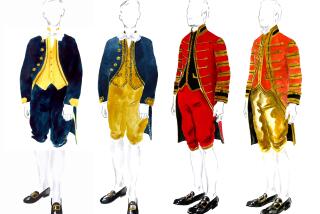In Quilting, Warm Glow of History Lends Joy to the Present Renaissance : Interest in Old-Fashioned Art Form ‘Just Keeps Growing and Growing’
- Share via
NORCROSS, Ga. — Hundreds of years after the first frontier women gathered scraps of cloth to make quilts, this unique art form is experiencing a rebirth that both surprises and delights 36-year-old Anita Weinraub.
Just as the old folk song “Seeing Nellie Home” says, there are still many Aunt Dinahs holding quilting parties and many sewing Nellies being seen to their homes after the quilting bash is over.
“It is very popular. It strikes a sentimental chord in many people,” Weinraub said. “One hundred years ago, people quilted out of need. Today people want to make something beautiful for their homes or to express themselves.”
Making those warm quilts that are so welcome on the bed when the nights are cold has not changed much over the years, Weinraub said. Although some women now use computer programs to design their patterns and to help in color coordination, the old-time wood frame is still used to hold and stretch the quilt while it is being worked on by one or more women.
Weinraub, who is self-employed in real estate, got hooked on quilting more than three years ago. She was fascinated by their beauty, utility and the literally thousands of patterns and color combinations.
‘Caught the Fever’
“I always wanted to make a quilt,” she said. “I caught the fever and it stayed with me.”
Quilting “is becoming recognized as a women’s art form and should be preserved.”
And although the modern American woman is no longer seen in the homemaker role, there are many who still gather for old-fashioned quilting parties or quilting bees, contributing to the resurgence in quilt making, Weinraub said.
Her interest in making quilts may be equaled or exceeded by a desire to preserve this bit of Americana.
“Quilts are artifacts from our past,” Weinraub said. “By their very nature of construction, material and the oral history provided by their owners, they constitute a rich but perishable body of information about the lives of the people who made and used them. This should be recorded and documented, and the sooner the better.”
Quilt Surveys
Weinraub, a member of the North Georgia Quilt Council, said quilting guilds in more than 35 states have completed or started quilt surveys in which these treasured items from the past are documented, registered, photographed and their histories recorded. Some state quilting guilds have published books with photographs and histories of the more interesting quilts.
Weinraub has launched an ambitious effort to do a similar survey in Georgia by holding “quilt days” in various parts of the state where quilters bring in their family quilts to be documented and photographed. She hopes that once this is done, the information will recorded and placed on file in the Georgia Archives.
Weinraub says family history did not play a part in her interest in quilting.
She has made nine quilts in her spare time. One, which she quilted to give as a wedding present, took nine months.
In early American history, women made quilts by sewing scraps of cloth together. Eventually, when cloth became more available, quilters could plan patterns and colors. Some quilts made in the 1700s are still in existence and are proud family possessions, Weinraub said.
“One or more women could work on a quilt at the same time and quilting parties were big social occasions,” she said.
Quilts consist of three layers--a top of calico or polyester, a bottom, usually muslin, with bedding material in between. The layers are put in a wood frame or hoop, where they are stretched tight and quilted together with a special quilting thread.
Some women eschew the frames and hoops, using sewing machines to speed up the work.
“Many of the early quilt patterns were taken from something in everyday life,” Weinraub said. Some well-known patterns depicted a log cabin, flying geese, a double wedding ring or a moon coming up over a mountain.
Quilting declined in the early 1920s, Weinraub said, but experienced a big resurgence during the Great Depression of the 1930s when women used feed sacks to make quilts or reverted back to saving scraps of cloth and piecing them together.
The most recent resurgence began about 1976 and “it just keeps growing and growing,” she said.
Every state has a quilting guild, said Weinraub, and there are several national organizations. The two largest are the American Quilters Society and the National Quilting Assn.
More to Read
The biggest entertainment stories
Get our big stories about Hollywood, film, television, music, arts, culture and more right in your inbox as soon as they publish.
You may occasionally receive promotional content from the Los Angeles Times.










